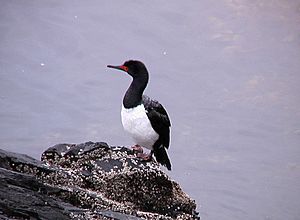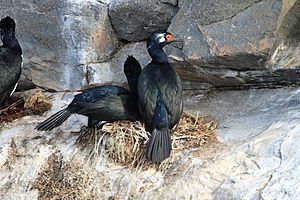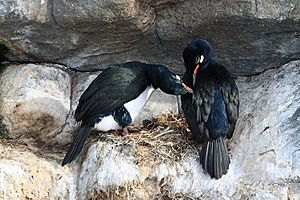Rock shag facts for kids
Quick facts for kids Rock shag |
|
|---|---|
 |
|
| Conservation status | |
| Scientific classification | |
| Genus: |
Phalacrocorax
|
| Species: |
magellanicus
|
The rock shag (Phalacrocorax magellanicus) is a type of sea bird. It is also known as the Magellanic cormorant. These birds live along the southern coasts of South America.
They breed from Valdivia, Chile, south to Cape Horn and Tierra del Fuego. They also breed north to Punta Tombo in Argentina. In winter, they travel further north. Some reach Santiago, Chile, and Uruguay. Rock shags also live and breed around the Falkland Islands.
Contents
What Does a Rock Shag Look Like?
From far away, the rock shag looks like a black and white bird. Its head, neck, and back are black. Its chest and belly are white.
If you look closer, the black parts can look metallic blue or oily green. They also have small white spots. Their legs and feet are a pink color. The skin around their beak and eyes is brick red.
When they are ready to breed, they have a small black crest on their forehead. They also get a clear white patch near their ears. Male rock shags are a little bigger than females.
How Rock Shags Find Food
Like all cormorants, rock shags catch their food by diving underwater. They usually hunt close to the shore. They often dive near beds of kelp, which are large seaweeds.
They seem to find small fish hiding among the kelp. These fish are mostly a type called cod icefishes. Rock shags are not very deep divers. They usually go about 5 meters (16 feet) deep. Few dive deeper than 10 meters (33 feet). Their dives usually last about 30 seconds.
Another bird, the imperial shag, also lives in the same areas. But imperial shags dive in deeper water, further from the shore. This means the two birds do not compete for the same food.
Nesting and Reproduction
Rock shags usually build their nests on ledges. These ledges are found on steep, bare, rocky cliffs.
A female rock shag typically lays three eggs. Sometimes, nests can have two to five eggs. Their nesting groups can be small, with only five pairs of birds. But some groups can be very large, with almost 400 pairs.
About Their Name
Some scientists place the rock shag in a different group of birds called Leucocarbo. This group includes other cormorants often called "shags."
Studies show that the rock shag is related to other cormorants that nest on cliffs. These include the red-legged cormorant, the pelagic cormorant, and the red-faced shag.
See also
 In Spanish: Cormorán magallánico para niños
In Spanish: Cormorán magallánico para niños




